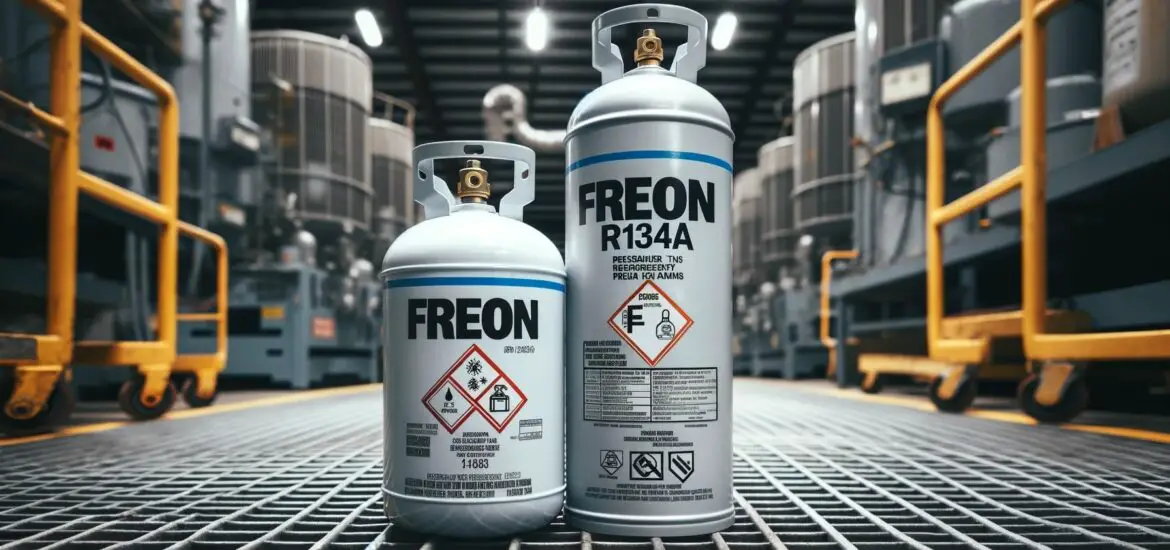This guide is designed to demystify the difference between Freon and R134a and equip you with all the necessary information to understand these refrigerants completely.

Table of Contents
What Exactly is Freon?
Freon, traditionally a household name when it comes to refrigerants, is a term that covers a group of chemicals used in refrigeration and air conditioning. In essence, Freon belongs to a class of compounds known as chlorofluorocarbons (CFCs), hydrochlorofluorocarbons (HCFCs), and in some formulations, hydrofluorocarbons (HFCs), although ‘Freon’ is often used in reference to CFCs and HCFCs.
Each of these compounds has been utilized for its excellent thermodynamic properties, allowing for effective heat transfer in various cooling systems.
Despite its widespread use and effectiveness in refrigeration, the discovery that CFCs and HCFCs were significantly depleting the Earth’s protective ozone layer led to the gradual discontinuation of these substances. This phase-out was bolstered by international agreements, starting with the Montreal Protocol.
The agreement’s main objective was to cease the use of ozone-depleting chemicals, which included several Freon refrigerants. Thus, although ‘Freon’ became synonymous with refrigerants, it is now a term that connotes environmental harm and outdated technology.
Understanding R134a
R134a is a non-ozone-depleting refrigerant known chemically as 1,1,1,2-Tetrafluoroethane. Falling under the HFC category, it has been adopted widely as a replacement for CFCs and HCFCs.
R134a gained popularity as it does not contribute to the ozone layer’s depletion, making it a more environmentally responsible choice compared to its predecessors. Its chemical stability and safety profile in terms of toxicity and non-flammability made R134a the refrigerant of choice in a variety of applications, particularly automotive air conditioning.
Nevertheless, R134a is not without its own environmental drawbacks, as it is a greenhouse gas with a global warming potential (GWP). This has led to its use being regulated and, in some applications, phased out in favor of newer alternatives with lower GWPs.
Difference Between Freon and R134a
In this section, we’ll clearly reveal the difference between Freon and R134a as we compare them in 4 distinct categories.
Environmental Impact
The environmental impact of refrigerants is measured by two main factors: their ozone depletion potential (ODP) and global warming potential (GWP).
Freon refrigerants, particularly those that are CFCs and HCFCs, have high ODP due to their chlorine content. When released into the atmosphere, they contribute to the thinning of the ozone layer, which protects the Earth from harmful ultraviolet radiation.
R134a, on the other hand, has an ODP of zero, making it a safer choice for the ozone layer. However, its GWP is significant and estimated to be over 1,300 times greater than carbon dioxide. This means that while R134a is not harmful to the ozone layer, it can still contribute substantially to global warming if released into the atmosphere.
Efficiency and Performance
When discussing refrigerants, efficiency refers to how effectively they can absorb and release heat.
Freon was known for its high efficiency and performance, making it an industry standard for many years. However, systems designed for Freon typically cannot accommodate R134a without adjustments due to the latter’s different pressure characteristics and the need for specific lubricants compatible with R134a’s chemical properties.
Performance is not solely about the chemical properties of the refrigerant but also about how well it works with the components of a refrigeration system, such as compressors and evaporators. While R134a systems are designed to be efficient, the transition from Freon requires careful consideration of the entire system to maintain or improve performance levels.
Legal and Safety Considerations
The legal landscape for refrigerants is largely shaped by their environmental impact. With the phasing out of ozone-depleting substances, Freon-based CFCs and HCFCs have become heavily regulated and are illegal to produce or import in many countries. While R134a is currently a legal refrigerant, it is subject to regulations that manage its handling, recycling, and disposal due to its high GWP.
From a safety perspective, both Freon and R134a are non-flammable and low in toxicity, making them safe for use in various settings when handled correctly. However, the safe handling of these substances requires adherence to proper protocols, as refrigerant leaks can lead to asphyxiation in high concentrations or can contribute to climate change if released into the atmosphere.
Availability and Cost
The availability and cost of Freon and R134a are heavily influenced by regulatory measures and market demand. As the production of Freon has been restricted globally, existing stocks have become more scarce and expensive. This trend is likely to continue as remaining stocks are depleted and no new production occurs.
R134a is currently widely available and relatively inexpensive due to its widespread acceptance and production. However, as the industry moves towards refrigerants with lower GWPs, the availability and cost of R134a may change. It’s also important to consider the costs associated with retrofitting existing systems designed for Freon to use R134a or other alternatives, which can be a significant investment.